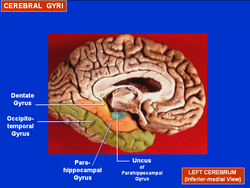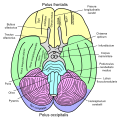| Parahippocampal gyrus | |
|---|---|
 Human brain seen from below. Parahippocampal gyrus shown in blue | |
 Medial view of left cerebral hemisphere. Parahippocampal gyrus shown in orange. | |
| Details | |
| Identifiers | |
| Latin | gyrus parahippocampalis |
| MeSH | D020534 |
| NeuroNames | 164 |
| NeuroLex ID | birnlex_807 |
| TA98 | A14.1.09.234 |
| TA2 | 5515 |
| FMA | 61918 |
| Anatomical terminology | |
The parahippocampal gyrus (or hippocampal gyrus [1] ) is a grey matter cortical region, a gyrus of the brain that surrounds the hippocampus and is part of the limbic system. The region plays an important role in memory encoding and retrieval. It has been involved in some cases of hippocampal sclerosis. [2] Asymmetry has been observed in schizophrenia. [3]











